Highway 2 cuts an interesting, meandering path through Michigan’s Upper Peninsula, wrapping up and around the northern reaches of Lake Michigan stretching from Escanaba to St. Ignace. This is widely regarded as one of the most scenic drives in the state, dotted with small villages and wide vistas overlooking the big lake. Naubinway is a small fishing village located along U.S. 2 at the very northernmost point of Lake Michigan, and it’s host to one of the true gems of vintage snowmobiling.
The Top of the Lake Snowmobile Museum has been open since July 4, 2007, and now houses one of the most eclectic groups of vintage sleds on display anywhere. You’ll find the old “iron dog” sleds that look like some sort of runaway mechanical fugitive from a mid 20th century farm implement store, all the way up through the metalflake painted, multi-piped free air monsters from the 1970s that many gray haired men fondly recall lusting after and reading about when they were in school. The museum actually grew out of a vintage show and ride held annually in Naubinway. In 2003, a few show regulars got together after the show to discuss the possibility of creating a more permanent, indoor display for some of the machines, and the idea of the Top of the Lake Museum was born. In 2006 the idea became more than a concept, as a business plan and mission statement were created, non-profit status was gained and fundraising became more intense. All of the hard work, endless meetings and money-raising efforts came together in 2007, when an old laundromat became available in town. Suddenly, the museum had a home.
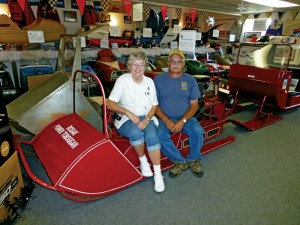 The collection of vintage machinery on display at the Top of the Lake Snowmobile Museum differs from most others in its incredible diversity. In addition to the usual Arctic Cats, Ski-Doos, Polaris and Yamahas commonly found in most vintage and classic snowmobile displays, you’ll find some of the most unusual and odd motorized vehicles to traverse the winter northwoods at the Naubinway facility.
The collection of vintage machinery on display at the Top of the Lake Snowmobile Museum differs from most others in its incredible diversity. In addition to the usual Arctic Cats, Ski-Doos, Polaris and Yamahas commonly found in most vintage and classic snowmobile displays, you’ll find some of the most unusual and odd motorized vehicles to traverse the winter northwoods at the Naubinway facility.
Some of the more noteworthy sleds displayed there include the metalflake bronze 1971 Phantom, which was built in West Virginia, of all places. The 1972 Sno-Coupe was an innovative design in its day, featuring side-by-side seating and an enclosed cockpit and promised a “sports-car like ride.” The 1969 Sno Ghia was built in Turin, Italy, and featured what must have surely been the epitome of Italian-cool design in its day, but was arguably one of the worst snowmobiles ever built. Evidence of the Bell and Howell decision to throw its hat into the snowmobile ring in 1972 is on display with the “Howeller” prototype, which thankfully never made it into production.
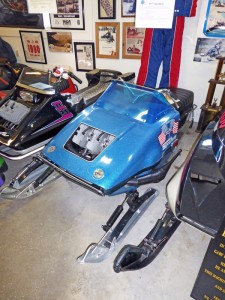 The one-of-a-kind, never-completed 1974 factory twin track prototype from the Mercury Racing department is worth the $5 cost of admission on its own. Other highlights in the collection include a 1957 Bosak Power Toboggan, 1958 Sno-Bi-Kin, 1959 Simko ice sled, 1965 Allis-Chalmers prototype, 1971 NGC and a very unique Arctic Cat Kitchen Cutter. There are also two rare Michigan-built brands, a 1969 Ski-Kat and a 1971 Big Boss.
The one-of-a-kind, never-completed 1974 factory twin track prototype from the Mercury Racing department is worth the $5 cost of admission on its own. Other highlights in the collection include a 1957 Bosak Power Toboggan, 1958 Sno-Bi-Kin, 1959 Simko ice sled, 1965 Allis-Chalmers prototype, 1971 NGC and a very unique Arctic Cat Kitchen Cutter. There are also two rare Michigan-built brands, a 1969 Ski-Kat and a 1971 Big Boss.
Many of the sleds on display from the oddball manufacturers in the late 1960s and early 1970s are almost cartoonish in appearance, which when combined with sub-par mechanicals doomed many of them from the initial production run. Just when you think you’ve seen the most unusual or unique sled on display, the next one will prove even more interesting. Make sure you set a couple of hours aside to visit the museum, as it will take a while to check out everything on display there.
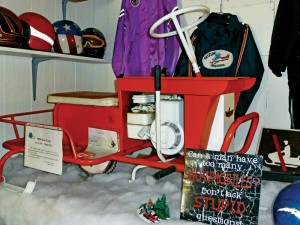 Complementing the 70-plus vintage sleds on display are old snowmobile dealer signs, along with sales and promotional items from over the years. A vintage snowmobile enthusiast could spend hours checking out all of the old products and accessories decorating the museum, most produced by companies that are no longer in existence.
Complementing the 70-plus vintage sleds on display are old snowmobile dealer signs, along with sales and promotional items from over the years. A vintage snowmobile enthusiast could spend hours checking out all of the old products and accessories decorating the museum, most produced by companies that are no longer in existence.
One company that is still very much in existence is the LeMans Corporation, parent company of snowmobile aftermarket powerhouse Parts Unlimited. The vintage LeMans branded products on the shelves here provide an interesting contrast to the current offerings from the modern snowmobile aftermarket.
Speaking of contrasts, the vintage snowmobile clothing on display is the antithesis of what the late model sledders are sporting on the trails today. The classic suits and helmets are sure to provide older riders with fond smiles, while the younger crew will probably shake their head in disbelief over what used to be considered “state of the art” snow gear from back in the 1960s and 1970s.
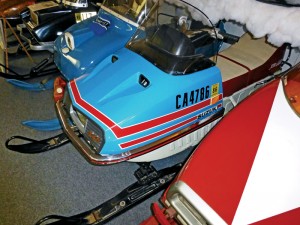 Your hosts at the Top of The Lake Snowmobile Museum, Charlie and Marilyn Vallier, have an encyclopedic knowledge of the machinery and accessories housed within the museum walls. Both serve on the 10-person board of directors for the facility, and Charlie also owns quite a few of the sleds on display. The Valliers are more than willing to spend time with visitors, explaining not only the history of the museum, but sharing personalized stories of the snowmobiles and related memorabilia on site. Taking the time to listen to these snowmobile historians’ short anecdotes will provide any visitor with a new and unique perspective of the vintage snowmobile scene.
Your hosts at the Top of The Lake Snowmobile Museum, Charlie and Marilyn Vallier, have an encyclopedic knowledge of the machinery and accessories housed within the museum walls. Both serve on the 10-person board of directors for the facility, and Charlie also owns quite a few of the sleds on display. The Valliers are more than willing to spend time with visitors, explaining not only the history of the museum, but sharing personalized stories of the snowmobiles and related memorabilia on site. Taking the time to listen to these snowmobile historians’ short anecdotes will provide any visitor with a new and unique perspective of the vintage snowmobile scene.
The museum is rapidly outgrowing its current building, and a fundraising effort is now underway to help the nonprofit 501(c)(3) corporation compile enough capital to build a new, larger, more high-profile facility with a much larger museum display area, a meeting room and an on-site snowmobile library. The museum is open daily from 11 a.m. until 5 p.m., but is closed on Tuesdays.
Top of the Lake Snowmobile Museum | Naubinway, Michigan
906/477-6298 or 906/477-6192; snowmobilemuseum.com



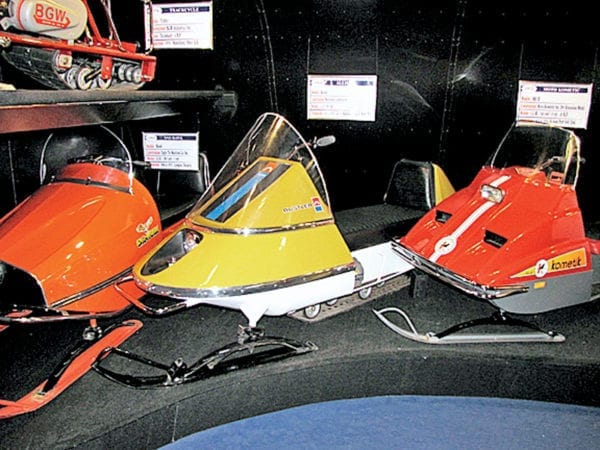
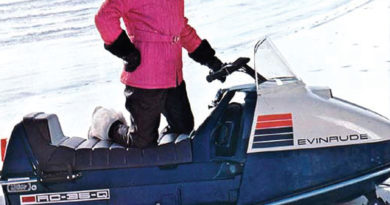
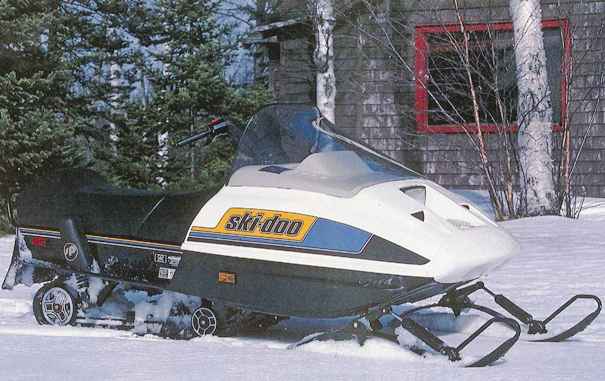
Pingback: 12 Fantastic Vintage Snowmobile Museums | SnowGoer